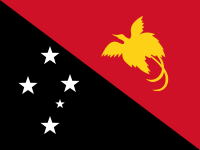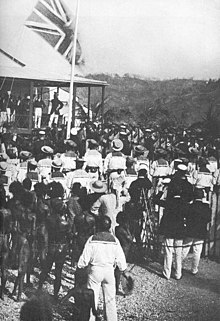Flag of Papua New Guinea
| Flag of Papua New Guinea | |
|---|---|
 |
|
| Vexillological symbol : |
|
| Aspect ratio: | 3: 4 |
| Officially accepted: | July 1, 1971 |
The flag of Papua New Guinea has been in official use since July 1, 1971, before the country gained independence in 1975.
Description and meaning
The national flag shows parts of the old coats of arms of the two former colonies from which Papua New Guinea arose - German New Guinea and Australian Papua .
Divided by a diagonal, the flag in the upper right triangle shows the heraldic bird of the German colony, a bird of paradise - in honor of an explorer of the island, the German ornithologist Otto Finsch , who also helped with the German occupation.
The lower left field shows the constellation Cross of the South on a black background , as it is shown on the flag of Australia .
history
In the German colony of German New Guinea, which forms what is now the north of Papua New Guinea, the tricolor of the German Empire was used. In 1914 there were plans for the German colony's own flag. However, they were never introduced due to the First World War . The flag of the German New Guinea Company , active from 1884 , showed the imperial colors on a white field in the upper left corner, while at the flying end of the flag a black, heraldic lion holds a red Bourbon lily in its claws. The population misunderstood this lily as a bloody bone .
With the loss of the colony to Australia , the flag of Australia became the valid symbol in the colony.
- New Guinea
 ? German New Guinea Compagnie , 1884–1914
? German New Guinea Compagnie , 1884–1914
 ? German Empire in New Guinea, 1899–1914
? German Empire in New Guinea, 1899–1914

 ? Draft flag for German New Guinea, 1914
? Draft flag for German New Guinea, 1914
 ? Australian Territory of New Guinea, 1914–1949
? Australian Territory of New Guinea, 1914–1949
Southeast New Guinea became a British New Guinea colony in 1883 . The colonial flag corresponded to the usual design: a Blue Ensign with a white disc on which a crown and the letters TNG rested for the colony . In 1901 the territory was subordinated to Australia. The flag was eventually used until 1906, when the area was renamed Papua Territory . Now the flag said Papua .
- Papua
 ? British New Guinea , 1884–1901 (possibly until 1906)
? British New Guinea , 1884–1901 (possibly until 1906)
 ? Australian Territory of Papua , 1906–1949
? Australian Territory of Papua , 1906–1949
 ? Governor of Papua, 1906–1949
? Governor of Papua, 1906–1949
The two areas were united to Papua New Guinea in 1949, but still under Australian administration. The flag of Australia was now used in both areas.
The first dedicated flag for Papua and New Guinea was a so-called sports flag, which was used since 1962 and was used at competitions in Oceania . The national flag at that time was still the flag of Australia. The sports flag showed a bright green cloth to the leech offset towards white bird of paradise.
From 1964 onwards the introduction of a national flag was discussed in public. A commission set up specifically for this purpose endorsed a blue-yellow-green vertical striped tricolor with a white southern cross in the front and a white bird of paradise in the back. The committee traveled around the country with the draft proposals, but met with little interest in a flag draft.
- Papua New Guinea
 ? Australian Territory of Papua and New Guinea, 1949–1965
? Australian Territory of Papua and New Guinea, 1949–1965
 ? Australian Trust Territory of Papua and New Guinea, 1965–1970
? Australian Trust Territory of Papua and New Guinea, 1965–1970
 ? Australian Trust Territory of Papua and New Guinea, 1970–1971
? Australian Trust Territory of Papua and New Guinea, 1970–1971
After heated debates in parliament, the competition design by Susan Karike Huhume , a student at a Catholic mission school, was accepted on March 4, 1971 , and officially introduced on July 1, 1971. Susan Hareho Karike chose the colors red and black because they play an important role in local art.
More flags of Papua New Guinea

 ? Naval War Flag of Papua New Guinea
? Naval War Flag of Papua New Guinea
See also
Individual evidence
- ^ Heiner Wesemann: Papua New Guinea, Culture - Landscape . In: DuMont documents . DuMont Buchverlag, Cologne 1985, ISBN 3-7701-1322-5 , p. 140 .
literature
- Karl-Heinz Hesmer: Flags and coats of arms of the world. History and symbolism of the flags and coats of arms of all states . Bertelsmann Lexikon Verlag, Gütersloh 1992, ISBN 3-570-01082-1 .
Web links
- Flags of the World - Papua New Guinea (English)












